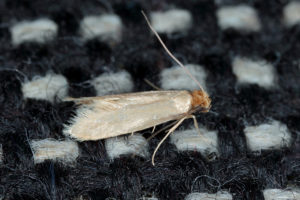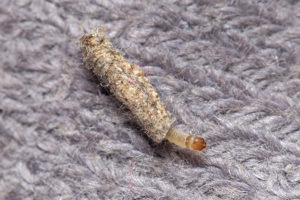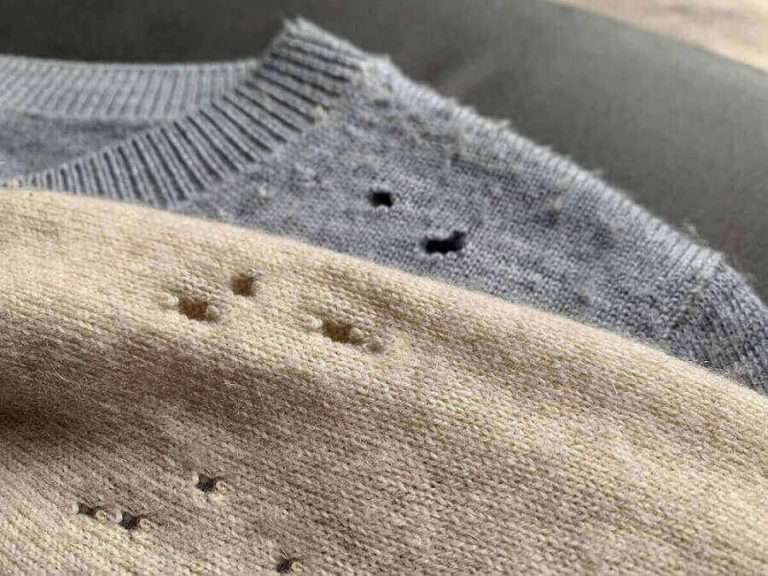If you work from home and have been wearing sweatpants every day or are preparing to pull out all your cold weather clothes, there is a good chance you’ll find some holes in your clothing if they weren’t properly stored. Pesky little clothes moths infiltrate closets and love to chew on cashmere sweaters and carpets.
If you’ve noticed small holes, it’s likely due to webbing and case-bearing moths, commonly known as clothes moths. Case-bearing moths don’t actually chew holes, they graze the clothing top layers, which is hard to notice.
Whichever clothing moth you’re dealing with, there are plenty of ways to rid them of your wardrobe. And no, I am not talking about moth balls. They have been proven to leave behind harmful toxins, and a permanent awful smell. I’ll lay out various solutions to prevent moths from eating your clothing and to get rid of them if they already infested your clothes.
Where Do Clothes Moths Come From?
The most common clothes moth is the webbing moth, they emerge during the warmer weather in the spring, and adults will lay their eggs in dark, undisturbed areas (like your closet!). Check out our quick guide to storing your summer clothes.
A female will lay hundreds of barely visible eggs during her lifetime, and they will lay them on animal fiber-based clothing, so the eggs have unlimited amounts of food once they hatch and turn into larvae. The flying moths you see surrounding your porch light are not responsible for the holes in your clothes.
Do Moths Eat Clothes?
Contrary to what most people think, the adult moths are not eating your sweaters, it’s the larvae which are solely responsible. They spend their entire time eating and foraging for wool and cashmere material mainly. They are nearly transparent, tiny caterpillars, so I don’t blame you if you thought it was the adult moths doing the damage.
Aside from clothing, the moth larvae will also feast on wool carpets and rugs. These can be especially beneficial to the moths as they can hatch underneath the carpets and do their damage from below.
What Attracts Moths to Clothing?
The larvae of clothes moths are attracted to clothing because of the animal-based fibers that contain keratin – a protein also found in dust. Most of the dust found on clothing is made up of human skin cells and hair shed by its owner. Moths aren’t attracted to cotton, as it does not contain much keratin, but they will still try to eat it.
The most common textiles targeted by clothes moths are wool, merino, angora, cashmere, silk, feather, and fur. Basically, any clothing that has keratin. Moths also prefer dirty, smelly clothing due to the lingering body oils, food and drink stains, and smells.
The case-bearing moth is also attracted to clothing because the larvae eat keratin, but these types are more commonly found chomping on rugs and carpets.
What do Clothes Moths Look Like?
As mentioned before, webbing and case-bearing clothing moths are most common. According to mothprevention.com, the Webbing Moth, is easily identified by a golden color and is around half an inch in length. The Case-Bearing Moth, is about ½ inch long and their forewings are brown with one large and a few smaller indistinct black spots. Case-bearing moths will build a portable case out of hair and fiber debris to hide in. Kind of cute right?


(Webbing moth on the left and case-bearing on the right.)
How to Get Rid of Clothes Moths and Protect Clothing
The easiest way to protect your clothing is to purchase sealable storage bags to prevent larvae from accessing the clothes. On Amazon and Bed Bath & Beyond there are selections of canvas zippered sweater bags which will be your best bet. I advise against anything made from plastic or cardboard because they trap moisture and create humid, moth-friendly spaces.
For clothing that needs to be hung up like dresses and winter coats, cotton hanging bags that zip all the way closed will be perfect. If you already have hanging bags that have a small opening at the top for the hanger, just use some duct tape and tape the open section shut. Suitcases work too to protect from moths, and you can already have a bag packed for future vacations.
Tips for How to Keep Clothes Moths Away
As I mentioned earlier, mothballs are not the best solution, but they will still do their job while making your clothes smell awful. Cedar wood blocks or chips are also a popular solution, but they leave oil stains on your clothing and can cause damage.
Lavender pouches that you can hang in your closet or put in drawers are a great solution as it keeps moths away and keeps your clothes smelling fresh. You can also look for lavender essential oil to put on your clothing while hand washing. Lavender has terpenes such as linalool, camphor, and linalyl acetate which are thought to help repel moths and other insects. You can find hanging lavender pouch packs on various sites, such as Amazon.
While lavender is a preventive measure, if you think that moths are already infested in your closet and on your clothing. It’s best to hand-wash the clothes or use the wool setting on your washer with detergent made for protein-based fibers. Look for wool and cashmere shampoo as well as fabric wash and the larvae should be off your clothing in no time. You can also use an iron to heat up your clothing and kill any larvae still on the fibers.
One other thing you can do to catch the pesky moths in your closet is to use pheromone traps. These traps are non-toxic and sticky and attract male moths with an artificial scent of a mate. Moths can detect pheromones from hundreds of feet away, so only place one trap or they can get confused.
Using a Storage Unit for Moth-Free Clothing
After doing some preemptive measures that I mentioned above, consider storing your extra sweaters or winter coats in self storage. If your clothes are cleaned and maybe scented with some lavender, they could be more likely to come out in pristine condition the next time you want to use them. Check out our Self Storage Calculator and find the perfect unit near you.


